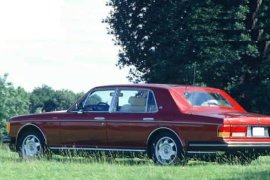BENTLEY Flying Spur Models/Series Timeline, Specifications & Photos
First production year: 1994
Engines: Gasoline
Rolls-Royce didn't want to make performance vehicles. That was a job for other brands, but it didn't want to be the slowest luxury car on the road either, and that's why it made the Flying Spur.
The British luxury carmaker built the Silver Spur for more legroom in the back. Then, the added weight needed more power, so the carmaker put a turbocharger on the V-8 engine under the hood so its owners wouldn't complain about the vehicle's performance.
From the outside, there was little difference between a Silver Spur and a Flying Spur. They both shared the same front fascia with the straight silver radiator and the Spirit of Ecstacy on top and the large squared headlights with corner-mounted turn signals. From its sides, the car featured a unique design for the light-alloy wheels, with seven thick spokes, while the Silver Spur featured a turbine-style set.
Inside, the carmaker placed more wood veneers than on any other premium car from that era. The entire dash panel was covered in wood, while the upper area and the visor sported hand-stitched leather. On the center console, the carmaker engraved the Flying Spur words on a lid, just in case someone from inside the vehicle wouldn't know. An outside temperature gauge and a clock adorned the area above the center stack. The leather-clad interior required more cow skins than any other limousines in the world. Its flat front seats were designed for comfort, and so was the bench in the back.
Under the hood, Rolls-Royce installed a 6.75-liter turbocharged V-8 engine that produced more torque than any other car from that era. Its 360 hp engine and 750 Nm (553 lb-ft) rocketed the 2.4-ton (5,445 lbs) vehicle from zero to 60 mph (0-97 kph) in seven seconds flat.
